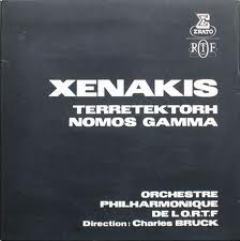Iannis Xenakis - Terretektorh & Nomos Gamma (1972)
Iannis Xenakis - Terretektorh & Nomos Gamma (1972)

1- Terretektorh 2- Nomos Gamma Orchestre Philharmonique LO.R.T.F. Charles Bruck – conductor
After the initial impact of his first orchestral scores (Metastaseis and Pithoprakta), which turned the modern music world on its ear in the mid-1950s, Iannis Xenakis turned to other concerns. He worked on developing a theoretical basis for his mathematical approach to composition, worked in the electroacoustic studio at Radio-France, and wrote some chamber and stage works. In 1966, however, his attention was drawn back to the orchestra and he penned a second set of pretty remarkable scores. Terretektorh, the first of these, was commissioned for the new contemporary music festival in Royan, a picturesque French town on the Atlantic just north of Bordeaux. Those were heady days, when festival organizers were not shy of allowing a composer like Xenakis take the orchestra and scatter all the players around and throughout the audience. In his words, he wanted to create a "Sonotron: an accelerator of sonorous particles." Indeed, the opening three minutes of the piece centers on a single note, passing it around the musicians to create a swirling effect that is impossible to achieve electronically (unless you have 88 channels of sound, perhaps!). Terretektorh shows more concern for harmonic organization than the earlier, iconoclastic Pithoprakta, with its scatterings of knocking sounds and massed effects. Still, the concentration is decidedly on texture and movement, with narrow lines being bundled with a number of others in the same register to create a rawer sonic intensity that still has some basis in melody. Xenakis concentrates on the high and low registers, as did Varèse before him, and adds some unusual sound effects into the mix as well. Each player of the orchestra, in addition to his or her own instrument, is required at various times to play from an arsenal of percussion instruments, including woodblocks, whips, maracas, and siren-whistles. These sounds are spread around the orchestra, creating "flames" of sound (sirens), or "clouds" of noise-like textures. For perhaps the first time, members of the audience could hear the orchestra from the "inside;" it may not always have been comfortable (imagine being seated directly in front of a trombone!), but it certainly would have been exhilarating!
Nomos Gamma is a large, ambitious work for orchestra that follows on from Terretektorh (1966), both of them commissioned for the newly established Royan Festival. Both pieces distribute the members of the orchestra throughout the audience, inviting the listener right inside the ensemble. Nomos Gamma also follows on from Nomos Alpha, for solo cello, again from 1966, in the composer's application of certain new mathematical principles to the compositional process. After spending several years implementing probabilities into his formal procedures, Xenakis turned to deterministic, combinatorial tools. In essence, sequences of different combinations of a range of musical elements or parameters are combined to form the compositional design. Nomos Alpha was the first result of this new approach to musical architecture, and Nomos Gamma was the next (there are sketches for a Nomos Beta, but the piece never saw the light beyond the composer's papers). As a follow-up to Terretektorh, which had caused such a sensation at its 1966 premiere in Royan, Nomos Gamma is both more careful in its construction and more audacious in expression. Whereas the earlier piece focused almost entirely on texture and the effect of sonic motion, the later piece includes straightforwardly melodic elements and a more block-like construction. The effect of hearing a three-part, microtonal melodic texture from within the middle of the instruments is still, of course, an entirely different, and much more visceral, experience than hearing it from afar. Xenakis makes great use, too, of teemingly dense string textures, which many layers of different kinds of sonorities occurring simultaneously. These are intercut with other, more compressed textures, with all the strings playing glassy, sustained harmonics, for example. The brass and woodwinds are, perhaps for the first time in his output, treated as equal to the strings, with dense clusters battling against plaintive melodic passages. Each of the five main sections of the piece is dominated by one of the orchestral instrumental groups: I. woodwinds; II. brass; III. woodwinds; IV. strings; V. percussion. The final section would be positively dizzying to hear in concert. The eight percussionists, placed around the perimeter of the orchestral-audience space, pass drum rolls around, one to another, at an incredible clip. Where Terretektorh wound the musical energy up at the beginning by passing a sustained unison pitch around the orchestra, Nomos Gamma cranks itself up at the end, spinning off like a crazed top, ending with a final outburst by all of the percussionists together. The experience must have been inspiring; Xenakis would try it again the following year in Persephassa, for six percussionists, also directed to encircle the audience (and wind them up!). --- James Harley, Rovi
download: uploaded yandex ziddu anonfiles 4shared mega sugarsyunc mediafire mixturecloud
